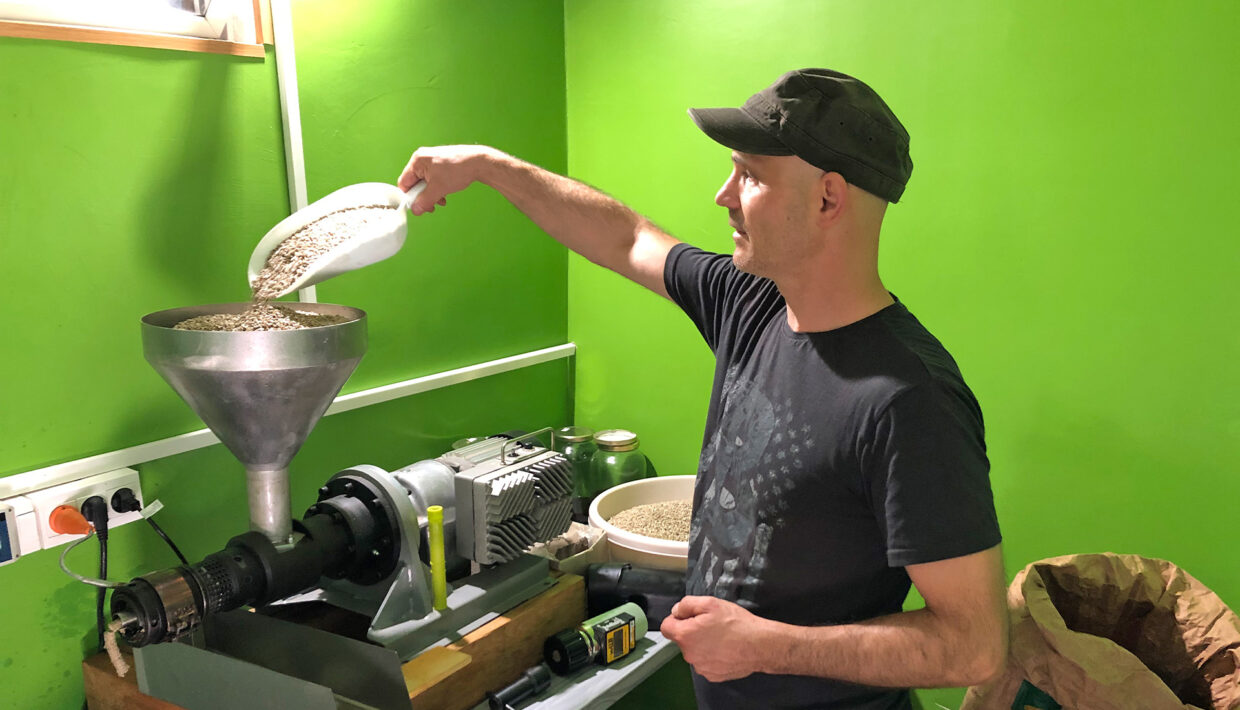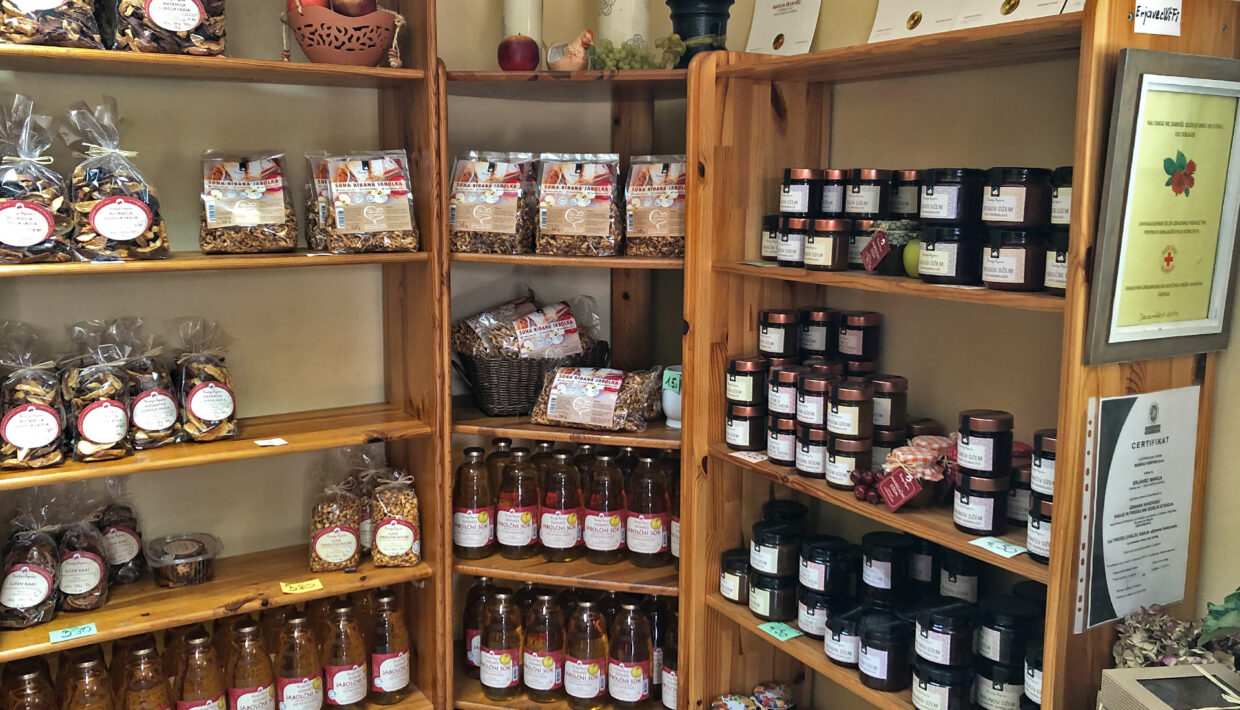In two weeks the pumpkin harvest will start again. Dušan Kos is looking forward to it. He just bought a new machine, which now shines in the sunlight in the farmyard in Pragersko, a village in the North East of Slovenia, about 25km from Maribor. With this machine the harvest of his six hectares of pumpkins will go even more smoothly. It cost him about €5,000 (£4,237), but he was able to afford it because his wife, Brigita Hergan, receives a European subsidy from the Young Farmers’ Scheme. If she works full-time on the family farm for three years, she will receive €45,000 (£38,137). It was a good motivation for the couple to change course completely.
Previously, Mrs Kos’ family milked 60 cows and did some arable farming. Two years ago there was a big discussion within the family: Should they invest in a new milking parlour, at a time when the milk price was very low, or should they do something else? Mrs Hergan and her husband saw a new future ahead of them: Processing their home-grown pumpkins and sunflowers into pumpkin and sunflower oil. “With six hectares of pumpkins and two of sunflowers, we’re not a big farm,” she says. “So, to ensure a good income, we need to add value to our products.”
Her father gave her the opportunity to start this new enterprise and made space available on the farm. Mrs Hergan went to the Slovenian Chamber of Agriculture for advice, and her husband, himself working five days a week as a factory manager, took care of the technical aspects. He built a processing room and figured out how to turn pumpkins into high-quality cold-pressed oil.
The cows are gone now. Mr Kos converted the stable and installed a heating system, which enables him to dry the seeds and heat the house. It cost him €25,000 (£21,176). “There are also other drying facilities around here, but as a grower you can become too dependent on them. I want to be able to dry my seeds when I want to. If they are left too long, it doesn’t do any good for the quality.” Now they produce 3,000 litres of pumpkin and 1,000 litres of sunflower oil a year, which they sell at farmers’ markets and in their own farm shop, which has given them a good connection with the local area. Mr Kos says: “That connection is crucial for us. We want to bring good quality products into Slovenian households.”
Rural areas under pressure
The couple are not the only farmers who, as small producers, want to build a connection with their local community. For many small farmers, that connection is key to surviving among larger farms. During the European agriculture ministers’ summit in early September 2021, the European Commissioner for agriculture, Janusz Wojciechowski, indicated that extra attention should be paid to the 10m small farmers in the European Union. “Economies of scale will continue, but it is precisely the small farmers who are important for maintaining the countryside,” he said. “The EU will therefore have to support these farmers financially.”
Yet the question is whether this financial aid is enough. The European countryside is under pressure, which of course isn’t only linked to farms getting bigger. Housing, infrastructure, investors; all these key players covet land, causing prices to skyrocket.
Small farmers are indispensable for the preservation of rural areas.
Janusz Wojciechowski, EU Commissioner for Agriculture
In Italy, internet company Amazon recently bought several hundred hectares of fertile farmland near Bologna to build a new distribution centre. In the Netherlands, investors are trying to acquire agricultural land on which to build solar parks. In Germany, city dwellers are looking for recreational opportunities outside the city, parking their cars in impossible places along rural roads, preventing farmers from doing their work with tractors and machines.
In addition, in many European countries; partly as a result of the COVID-19 pandemic, there seems to have been a migration from the city to the countryside. Citizens are looking for space and quiet in rural areas, which is changing the social structure enormously.
These changes come with an increase in neighbourhood conflicts. French agriculture minister Julien Denormandie commented: “Urbanites don’t know how things work in the countryside, so we have to explain that. We have to seek dialogue and, in my opinion, agriculture is the answer. By bringing farming closer to the rest of the population again, through the sale of local products for example, we can close the gap between the city-dweller and the farmer.”
Seal of approval as a mark of quality
That is what many small Slovenian farmers are trying to do. For 32 years, the monastery in the country’s oldest town, Ptuj, has been hosting a farmers’ festival every year: Dobrote slovenskih kmetij. Farmers sell their own produce here, but perhaps more importantly, there is a competition. This year, 500 farmers from all over the country submitted 978 products, which are judged in 15 different categories. The winners get to label their products for a year and the winning products are sold online on the festival website. Marija Erjavec’s apple cider is one of them. It makes her proud: “The quality mark gives customers confidence. It shows that it is of good quality.”
Together with her husband and son she runs a small fruit farm in Gorica, a village about 50km north of the capital Ljubljana. The farm consists of four hectares of apple trees, four hectares of arable land and 11ha of forest. They were pioneers in fruit farming in the early 1990s. “This region traditionally has no fruit cultivation at all, but at the time we only had two hectares and in order to get as much product from it as possible, we decided to plant apple trees,” Mrs Erjavec explains. “They produce more per square metre than potatoes.”
Now they produce about 90t of apples per year. They process these into all kinds of products, including dried fruit and apple vinegar. They also purchase pears, which they process in different ways. “We sell everything at local markets or speciality stores,” says Mrs Erjavec. “The farm shop has been there for 10 years. We were already at farmers’ markets, but people were calling to buy products at home as well,” she adds. “So, we started a shop. In the beginning we sold 80% of our products at home. Now it’s only 20%. Nowadays more and more companies ask for gift packages with local products. We jumped into that gap in the market too and it’s paying off.”
Improving prospects for small farmers
The country is committed to improving communication between urban and rural areas and expressed this during Slovenia’s EU presidency which ran from July to December 2021. “There are conflicts,” admits Slovenian minister of agriculture, forestry and food, Jože Podgoršek. “These arise mainly during farmers’ daily work. Non-farmers, for example, complain about lots of transport movements and about noise pollution. During our presidency, strengthening the dialogue between farmers and the non-rural environment was a top priority. We wanted to do something about that.”
He gives an example: “Some people in our hop-producing regions complain about the use of plant protection products. In response, we are implementing technical innovations that allow farmers to apply plant protection products more precisely. This will allow us to resolve the conflict between farmers and other people in that region.”
The Slovenian Chamber of Agriculture plays a crucial role in this. It represents 100,000 members, who work an average of eight to 10ha of land. The chairman, Roman Žveglič, is a small mountain farmer himself. He has 25ha of land, of which five is arable land. He also keeps 33 steers and 23 suckler cows in the Slovenian mountains. He explains the sticking points: “Agriculture is like football. Everyone thinks they know what’s what and acts like a football coach. The public wants safe, local food, without chemicals and pesticides, but they also want it cheap. These things do not go together. We need to explain that story more. I think that the small farmers in our country have an important task in this, because they are the ones who are close to the people around them.”

The Slovenian Chamber of Agriculture represents 100,000 members, who work an average of eight to 10 hectared of land and supports them among other things in developing new concepts for their farms.
Slavica Strelec works for the Chamber of Agriculture in the Slovenska Bistrica region. She and her regional team guide small farms in setting up new income streams. “They come to our office and together we look at what the possibilities are, in terms of technology, location and ensuring quality,” Ms Strelec explains. “In addition, we help farmers to obtain the right documents and papers to be able to process and sell products. This is a great opportunity for smaller farmers to remain farming in a world that seems to be all about economies of scale. Secondary activities are the only way to keep a small farm going.”
For Dušan and Brigita, this seems to have succeeded. After many investments and renovations, their business is now firmly planted in the Slovenian soil. Sales are booming. Other farmers in the area now ask the family if they can dry their seeds or offer their products for processing. Mr Kos points to the new reception area for visitors and is visibly emotional. “I never expected that we could build this up from just a small farm. But we did it,” he says, beaming. “This gives our family business a future again.”
Agriculture in Slovenia
Slovenia, officially the Republic of Slovenia is a country in central Europe at the southern edge of the Alps and became a member of the European Union on 1 May 2004. Slovenia has used the euro as its currency since 2007. It is bordered by Austria to the north, Italy and the Adriatic Sea to the west, Croatia to the south and east, and Hungary to the north-east. The country is small, densely forested and mountainous. The capital and largest city is Ljubljana and has a population of 286,745 (2020).
Agriculture is becoming less and less important to the Slovenian economy. In 2017, it contributed only 1.8% to the gross national product and only about 5.5% of the workforce was employed in this sector. As a result, Slovenia has become a net food importer. Farms are generally family farms with an average size of eight to 10ha which that are often affiliated to a co-operative.

Due to the climate and soil conditions, the agricultural land consists mainly of grassland. About 250,000ha are suitable for arable farming and horticulture and the main products are fruit, wheat, maize and potatoes. About 21,000ha are used for viticulture.
©Landenweb.nl/ Wikipedia







